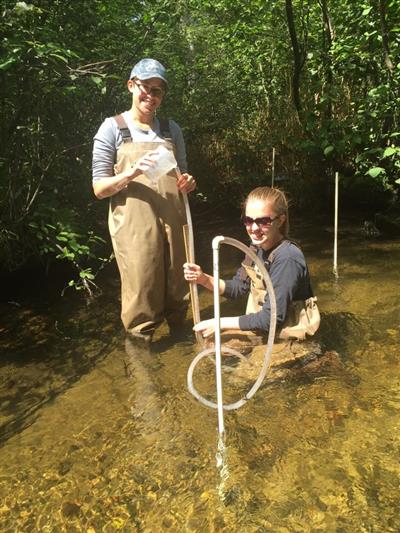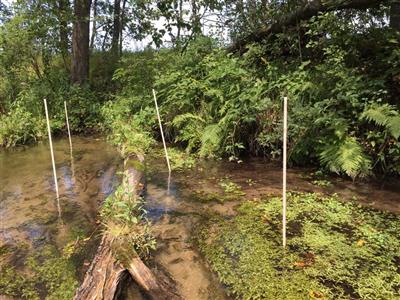
Credit: Robert Stelzer
October 14, 2015
By Aaron R. Conklin
In thousands of streams across the state of Wisconsin, there are points where groundwater bubbles up from beneath the underlying sediment, triggering chemical reactions at a microbiological level. One of those reactions is especially important to the health and quality of the stream water—in certain places, anaerobic bacteria in the sediments drive a critical process called denitrification, consuming nitrates in the water and converting them to nitrogen gas.
This is a big deal for the Central Sands Region of Wisconsin, where levels of nitrate in the surface water and groundwater tend to be higher than elsewhere in the state. And it’s here that Robert Stelzer, TRISS Professor of Biology at UW-Oshkosh, has trained his scientific eye. Backed by funding from the University of Wisconsin Water Resources Institute, Stelzer is studying streams to characterize the phenomenon and develop a predictive model.
“We’re focusing on where hotspots of denitirification and nitrate retention occur in the landscape,” said Stelzer. “It’s clear it doesn’t happen uniformly—the question is, can we predict where they will occur?”
Three of the biggest factors that will likely determine denitrification hotspot location are sediment type, how fast the groundwater moves through the sediments and the extent of groundwater-surface water interaction. Fine sediment with lots of organic carbon makes for a great hotspot. Conversely, groundwater-surface water interactions are eliminated or less important in urban streams with concrete bottoms, streams with bedrock slabs, or streams with lots of clay particles
Stelzer’s research team, which includes Dr. Thad Scott (University of Arkansas), is focusing on several streams in Central Wisconsin. The rate of groundwater movement is measured using piezometers (small wells) at 20—25 locations in each stream. The team measures denitrification in the field using MIMS (membrane inlet mass spectrometry). The collected data will determine whether the location chosen is a hot or a cold spot for denitrification and nitrate retention. Preliminary results show that hot and cold spots can be very close to one another, which can make identifying them challenging.
Organic matter—leaf and wood fall–is another key to promoting hotspots, as the carbon released during decay provides energy for the microbes involved in denitrification. Recognizing that could be useful to stream and watershed managers looking to promote denitrification in their streams.
“One of the broader goals of our work is to assess the importance of denitrification as an ecosystem service in a landscape,” said Stelzer. “Healthy streams can remove a lot of nitrate, but the natural processes can’t remove it all, particularly in landscapes that are overloaded. What would the deterioration of healthy stream systems do? Nitrate levels in groundwater and surface would likely be even higher with the reduction of the ecosystem service of denitrification that streams provide.”

Credit: Robert Stelzer
In a previous WRI research project, Stelzer showed that, on a small scale, adding organic matter to stream sediments promoted denitrification. It’s unclear if the scale could be increased to a level that would be useful to stream system managers, but the possibility is definitely there. So is the notion that hotspots could be reproduced in a stream that didn’t naturally have them.
“Placing a lot of organic matter in a stream artificially would be expensive,” noted Stelzer. “And there might also be unintended effects we might not anticipate. Maintaining healthy streams, which includes promoting natural inputs of leaves and wood, is probably a more cost-effective way to manage elevated nutrient concentrations in groundwater and surface water”
One of the goals of the project is to develop a model that would predict where denitrification hotspots occur in shallow groundwater associated with streams. Stelzer’s team also plans to do a spatial analysis that would result in maps of the hot and cold spots in select Wisconsin streams, as a visualization tool. Given the importance of elevated nitrate in ecosystems (negative effects can extend from local to areas far downstream) the model and tools developed could be extremely useful for predicting where groundwater-surface water interactions can maintain or improve water quality.



